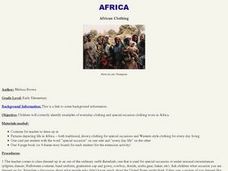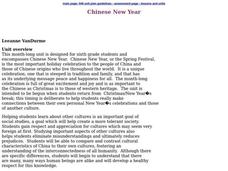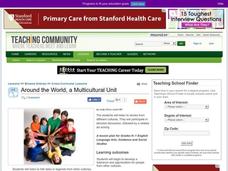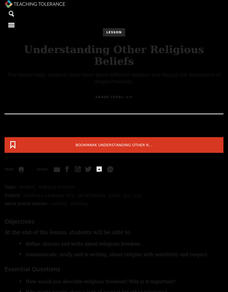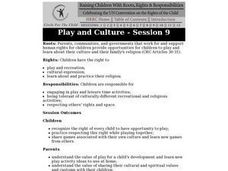Teaching Tolerance
Dismantling Racial Caste
It's time to end racism. The final installment of the series encourages scholars to consider what is needed to ended the racial caste system in the U.S. Young historians complete group discussion, written prompt, and a hands-on-activity...
Curated OER
Music in Other Cultures
Students examine the musical concepts of timbre, melody, and rhythm. They listen to and identify characteristics of music from other cultures.
Curated OER
Muslim Women Through Time
Students examine the culture and stereotypes of Muslim women and discover a combination of items have affected the role of Muslim women as a group and individually over time. Groups research a famous Muslim woman, present their...
Curated OER
Dude, Where's My Karma?
Students research various aspects of Indian culture. They create a Book of Knowledge about India. In a second activity they research the history behind any game. They make presentations and play the different games during Game Day.
Curated OER
African Clothing
Students explore African clothing. In this African culture social studies lesson, students brainstorm types of clothing they wear for different occasions. Students view photographs of Africans wearing Western clothing and "special...
Curated OER
Exploring Cultural Rituals
Learners analyze images and music of common rituals in America with those of other countries. They use worksheets to compare and contrast the events.
Curated OER
Cultures around the World
Students explore Canadian culture. In this Canadian Culture instructional activity, students participate in a general discussion about Canada, then create a symbol for Canada as part of a class collage.
Curated OER
"Bursting" Stereotypes
Students comprehend the meaning of the word steretype, work in groups to come up with stereotype statements, discuss whether the statements are fair, and write what they learned from the activity. Balloons are used as a conduit in this...
Missouri Department of Elementary
A Stranger Among Us
The final lesson plan in the R.E.S.PE.C.T series asks eighth graders to expand their vision beyond the walls of the classroom and to consider how they can promote acceptance and respect of others within in the global community. "A...
Curated OER
My Multicultural Self
Students examine the concept of multiculturalism. In this Teaching Tolerance lesson, students consider their self concepts and world views as they participate in an activity that requires them to describe themselves as well as major...
Curated OER
Korean TIP
Pupils discover different cultures and to compare and contrast those cultures to their own. They celebrate differences in culture as well as to better explore the dynamics of the similarities that make us one people. Students discuss...
Curated OER
Sadako and the Thousand Paper Cranes
Third graders explore their culture in comparison to Japanese culture by reading the book, Sadako and the Thousand Paper Cranes. They identify islands of Japan, create a Venn diagram comparing Japanese culture to American culture, and...
Curated OER
Chinese New Year
Sixth graders examine the culture and celebrations associated with Chinese New Year in this unit of lessons
Curated OER
Exploring Folk Traditions and Folk Beliefs
Ninth graders work together to brainstorm an idea to focus on the similiarties and differences between various cultures. Individually, they interview family members using questions they created based on their topic. They use their...
Curated OER
Around the World, A Multicultural Unit
Students investigate Native American tribes through their stories. In this cultural lesson, students read stories of the Inuit tribe and discuss the themes, people, and customs. Students illustrate a picture of the Inuit...
Curated OER
The Sounds of Change
Young scholars recognize that music brings out feelings and emotions in people. For this music themes lesson, students explore the relationships between culture and music. Young scholars answer questions about favorite choices in music.
Curated OER
Beauty
Learners bring an object to school that is of significant sentimental value to them. They arrange the objects in a class display, examine each other's artifacts and discuss the implications and cultural bias of the word 'beauty'.
Teaching Tolerance
Understanding Other Religious Beliefs
Learn what it means to respect others in an engaging lesson plan on religious beliefs. An inclusive resource focuses on understanding other religious beliefs, the right to freedom of religion, and the U.S. history of religious diversity....
Curated OER
Play and Culture
Students discuss with their parents the rights of every child to have the opportunity to play. They share games associated with their own culture and learn new games from others. They examine how the value of play for a child's...
Curated OER
A Comparative Study on Heroes in Hindu and Anglo-Saxon Cultures
Young scholars research Hindu and Anglo-Saxon religions and cultures. They research legends and myths about Hindu and Anglo-Saxon religious and cultural heroes. They write a comparison and contrast essay on the two cultures and their...
Curated OER
How Can Librarians Work To Eliminate Cultural Bias In The Organization Of Information?
Students explore the complexities of organizing information and to support librarians in developing strategies for reducing cultural bias. Students extend strategies to help raise solutions. Students list a variety of definitions on bias...
Curated OER
The borders of Europe. Geographically location or cultural artifice?
Twelfth graders discuss where they regard the boundaries of Europe to be. They raise their awareness that "Europe" may be more of a cultural construct than geographical defined continent.
Curated OER
Our Small World
Learners explore indigenous and Native cultures, and promote appreciation for the contributions from these cultures. They explore the concept of cultural conservation and gain more understanding about the issues that tribes face today. ...
Missouri Department of Elementary
What Is Important to Me?
Pupils complete an activity sheet to determine what values are most important to them. They then discuss their responses with partners before sharing the results of the discussion with the class.






